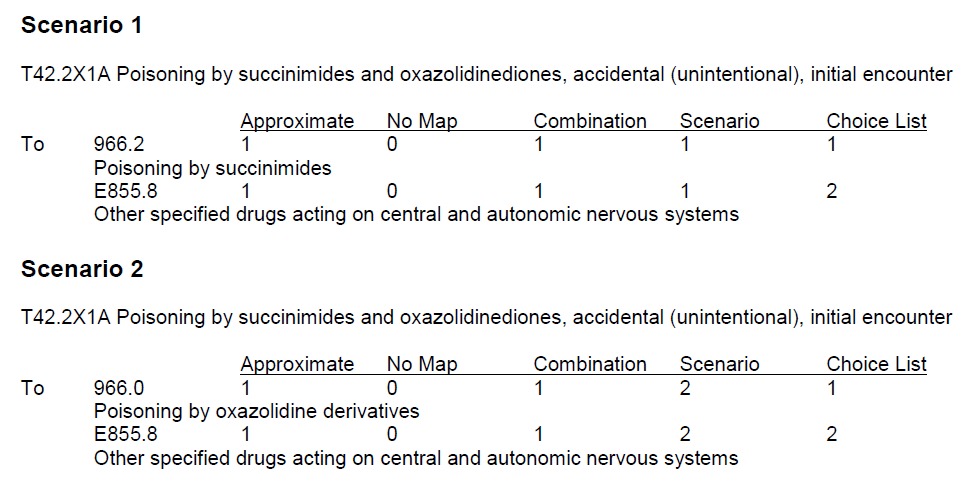Performs mapping to and from ICD-9 to ICD-10.
Diagnosis (CM) and procedure (PCS) codes is based on CMS general equivalence mappings (GEMs).
The purpose of the GEMs is to create a useful, practical, code to code translation reference dictionary for both code sets, and to offer acceptable translation alternatives wherever possible. For each code set, it endeavors to answer this question: Taking the complete meaning of a code (defined as: all correctly coded conditions or procedures that would be classified to a code based on the code title, all associated tabular instructional notes, and all index references that refer to a code) as a single unit, what are the most appropriate translation(s) to the other code set?
Mappings from specific concepts to more general concepts are possible; however, it is not possible to use mappings to add specificity when the original information is general.
The GEM provides an "approximate" flag (1st Flag). The approximate flag identifies entries where the complete meaning of the source system code and that of the target system code are not considered equivalent. The difference between the two systems is typically in level of detail between the codes, and in nearly all cases the I-10 code is more detailed than the I-9 code.
The approximate flag is 0 when the complete meaning of the source and the target are considered equivalent and the source and target translate only to each other in both GEMs files.
When the approximate flag is 1 the complete meaning of the source and the target are not considered equivalent.
The "no map" flag distinguishes entries where the source system code has at least one translation from entries where the source system code has no target system translation. Every effort is made to find an acceptable translation in the target system for every code in the source system. The no map flag is used only as a last resort, when there are no acceptable target system translation alternatives for the source system code.
In the I-10 to I-9 GEM, the “no map” flag is on for a large number of entries. In this example, the I-10 codes specify underdosing of a drug. I-9 does not contain an equivalent group of codes. Therefore, the I-10 codes cannot be linked to I-9 at all. In the I-10 to I-9 GEM the I-10 codes are listed without a corresponding I-9 entry, and with the “no map” flag on.
The combination flag distinguishes entries where the source system code has a single (meaning “non-combination”) translation alternative(s) from entries where the source system has a combination alternative(s). When the combination flag is on, the scenario and choice list fields in a GEM file contain a number. They appear last in a GEM file, after the flags. These numbers allow the user to collate the combination entries in the GEM.
T422X1A 9660 10121
T422X1A 9662 10111
T422X1A E8558 10112
T422X1A E8558 10122
The example above displays the I-10 to I-9 GEMs entry for I-10 diagnosis code T42.2X1A Poisoning by succinimides and oxazolidinediones, accidental (unintentional), initial encounter as it is depicted in the GEM text file format. Below, the entry is repeated with the code descriptions added and attributes labeled. The I-10 combination code T42.2X1A specifies both the diagnosis and the external cause, so it requires a combination entry in the GEM. A combination entry is subdivided hierarchically on two levels: 1) By scenario, the number of variations of diagnosis combinations included in the source system code, and 2) By choice list, the possible target system codes that combined are one valid expression of a scenario.
Each of the two types of drug listed in the I-10 code T42.2X1A is a unique I-9 code, so there are two scenarios from which to choose an applied mapping: one that specifies poisoning by succinimides and one that specifies poisoning by oxazolidinediones. Because each drug type listed in the I-10 combination code requires its own diagnosis code in I-9, each variation of the diagnosis is assigned a separate scenario number in the GEM entry.
A source system combination code includes diagnostic conditions or procedures that require more than one separate code in the target system to convey the equivalent amount of information. A combination code may also describe multiple variations of the information in either the code title or the complete meaning of the code. Each of these variations has its own number in the "scenario field" (the 4th flag).
"Choice lists" (the 5th flag) are the method of organization for the translation alternatives in a combination entry. Choice lists organize the distinct components of the target system translation in a combination entry into pick lists.
51884
99666
51881
V5877
73025
Sample ICD-9 CM and PCS files are included.
Above content adapted from CMS GEM Documentation and User Guides. Please refer to https://www.cms.gov/Medicare/Coding/ICD10/Latest_News for additional details. To learn more about the development of the GEM, I recommend reviewing the ICD MS-DRG Conversion Project information at https://www.cms.gov/Medicare/Coding/ICD10/ICD-10-MS-DRG-Conversion-Project.
https://www.cms.gov/Medicare/Coding/ICD10/2018-ICD-10-PCS-and-GEMs
https://www.cms.gov/Medicare/Coding/ICD10/2018-ICD-10-CM-and-GEMs
https://github.com/Ed-Nonnenmacher/ICD9-ICD10.git
https://github.com/bhanratt/ICD9CMtoICD10CM.git
